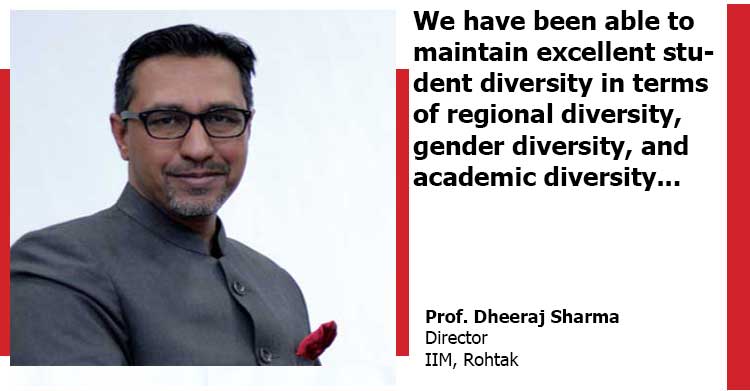Interview with Prof. Dheeraj Sharma | Director | IIM Rohtak

Q1. IIM Rohtak has been ranked amongst the top five IIMs in research and one of the premier institutes in India. What are the key components and respective weightage of short listing criteria in IIM-Rohtak?
IIM Rohtak shortlist the candidates based on CAT examination. IIM Rohtak shortlists students who are above the minimum cut-off of 95 percentile. The shortlisted candidates are invited for Personal Interview. The Personal Interview is typically used to assess the candidate’s academic understanding, general awareness, communication skills, extra-curricular, and co-curricular activities, among other things. IIM Rohtak looks to admit students from eligible and qualified applicants who are from diverse backgrounds, motivated to pursue management career, and well-rounded in the previous academic studies.
Q2. IIM Rohtak has the best gender diversity amongst all academic institutions in India. How is the institution working on maintaining gender diversity at campus?
I believe that one of the biggest strengths of IIM Rohtak lies in its excellent student diversity. We have been able to maintain excellent student diversity in terms of regional diversity, gender diversity, and academic diversity. In terms of gender diversity, the institute has been able to achieve the best gender diversity amongst any management education institution in the world. From 9% of the female students in its flagship programme in 2017, the institute has come a long way with over 70% of the female students for consecutively two years now. Therefore, IIM Rohtak is now number one in the world in terms of women representation in its MBA program. We have been able to achieve this extraordinary success with its resilience and consistent efforts over several years.
We designed a unique outreach program. We conducted interaction sessions in major cities and periodic online seminars to encourage women students to apply to IIM Rohtak. Further, we offered assistance to them in availing various state and central government scholarships. Next, we invited eligible women candidates along with their parents to visit the institute and interact with IIM Rohtak community members. These students were also provided AC 3 tier fare, local transportation, and campus stay facility for their visit. Finally, we were able to get four major banks that process a large number of education loans within 24 hours of application. Last year, more than 120 education loans were processed in 24 hours. As you would already know, the majority of the students who study at
IIM Rohtak avail education loans due to our facilitation. Through our efforts we were able to contribute to the ‘beti bachao, beti padhao’ initiative of the government.
Q3. What were the biggest challenges to call students on campus from Online to Offline classes? How did you and your team manage this?
Initially, the institute started inviting students on campus to attend online classes who either had issues with network connectivity at their home locations or needed higher academic support through personal attention of faculty members staying on campus. Gradually, we started receiving numerous requests from the students to move to the campus as they did not want to miss out on the peer learnings and interactions with their batch mates and faculty members. Institute started hosting students back on campus from the end of 2020 itself. However, coming to campus was not mandatory. Given the excellent vaccination drive conducted by the Government of India, it suddenly
became possible for us to bring all students who were double vaccinated to campus. We now have physical classes for our flagship programme.
However, in order to achieve this, the institute has adopted strict COVID protocols inside the institute. We have not only ensured mandatory double vaccination of all the students but also all the students who report on campus have to submit a negative RT-PCR report and are sent for mandatory 10 days of quarantine. They then have to undergo an RT-PCR test again. The entire hostel and academic facility is regularly sanitized and regular checks are made on the health and well-being of the students. Additionally, students were served meals and provided essentials in their rooms during the quarantine period.
Q4. India has the world’s largest higher education system in terms of number of education institutions, but its presence in the international education system has been abysmally below its true potential. Share your views on how Internationalization of higher education can be a game changer for India?
International higher education is an important sector and many students desire to pursue education abroad. As per media reports, over 750,000 students went abroad to pursue higher studies in the year 2019. On an average, Indian students spend $15 billion per year to earn these degrees. The new National Education Policy 2020 is an excellent opportunity to collaborate with foreign institutions and create top-class educational facilities by developing synergies. There is a possibility of Top 100 universities in the world to set up campuses in India. However, that endeavor will require collaboration with Indian institutions. If the right steps are taken the synergy between foreign and Indian educational institutions can result in offering the highest quality of education to the highest
number of applicants. Further, NEP will foster international collaborative research when Indian and global institutions interact with greater frequency. I believe that this will push more Indian institutions to adopt international standards in their curriculum and delivery of the courses. By leveraging on NEP 2020, India can become the epicentre of education for middle-east, Africa, and South-east Asia. I am also hopeful that by adopting NEP 2020, the higher education sector in India will get the necessary boost to enhance its standards and project India as a preferred global destination for education.


